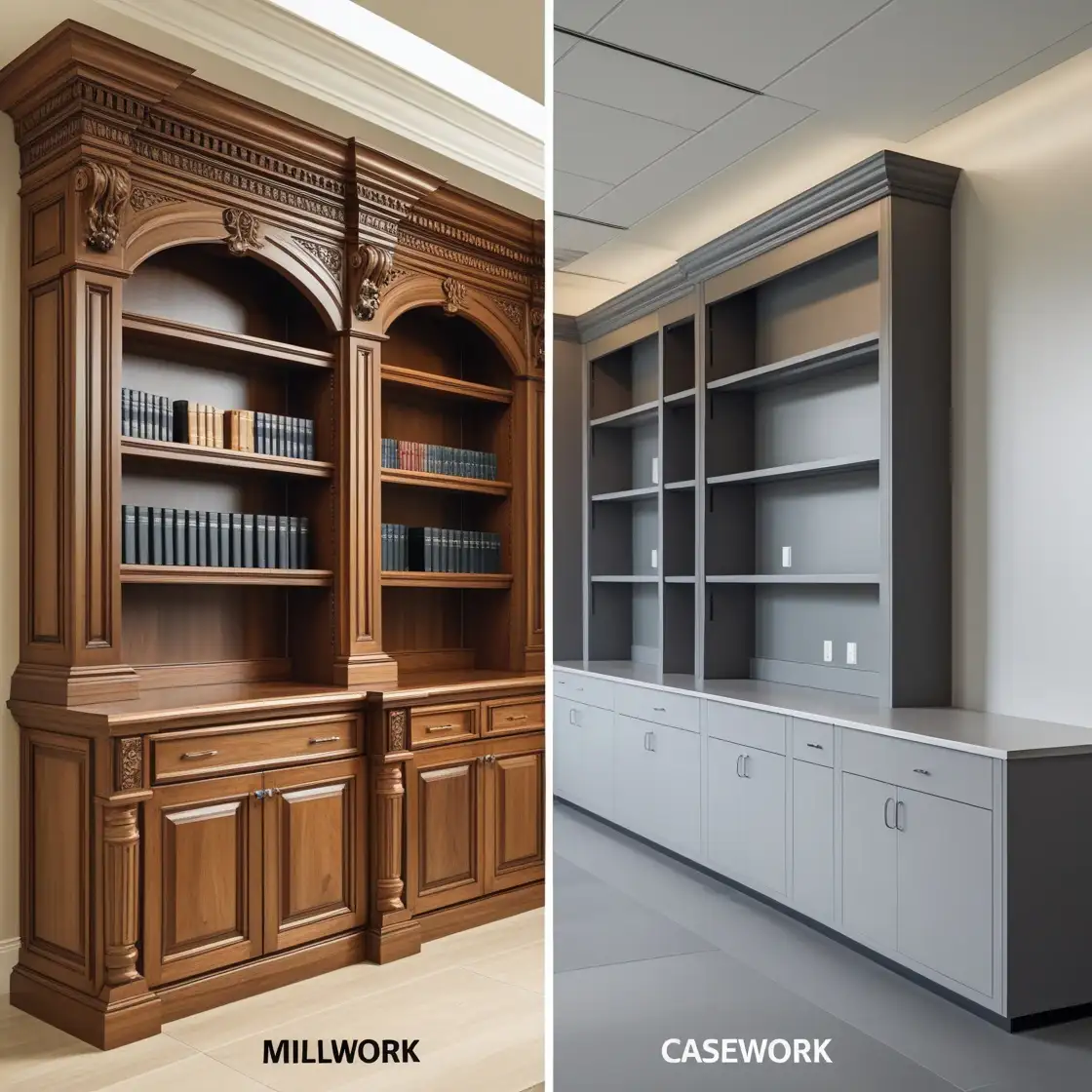You are at the right platform to discover Millwork vs Casework because most people confuse these two things. They use these two terms interchangeably, but they are not the same. Millwork and casework are similar in some ways, but they are different, which sets them apart in terms of CAD drafting and manufacturing perspective.
However, the main difference is about customization, which is built according to the client’s requirements. If you are a contractor and your next project is about millwork and casework, do not forget its financial management. For that, you can contact a reliable estimating firm, which will provide a detailed cost description with types and needs.
DIVE IN TO EXPLORE THE KEY DIFFERENCES BETWEEN MILLWORK VS CASEWORK TO UNDERSTAND HOW THEY DIFFER CONCERNING CUSTOMIZATION AND PURPOSE!
A guide to highlight the main differences: Casework vs Millwork
What is casework?
Casework is all about making boxes or box-shaped furniture. This process includes prefabricated and modular wooden material and components. After their production, they are assembled and joined on the site.
However, it is built according to the requirements of the project, sizes, materials, and design. Well, it is also affordable for all types of clients.
Some examples of casework are as follows:
- Cabinets
- Drawers
- Shelving units
- Bookcases
- Kitchen islands
- Vanities
- Closets
- Desks
- Credenzas
- Lockers
- Display cases
- Storage benches
- Wall units
- Pantries
- Filing cabinets and others.
Advantages of casework
Now, let us show you the realistic advantage of using casework:
- Provides a one-on-one approach for a better understanding of each person’s needs.
- Helps connect clients with useful services and resources.
- Looks at the whole situation, including social and emotional factors.
- Helps prevent problems from getting worse and offers solutions.
What is millwork?
Millwork is a finished product that is built and designed in a mill. Its use is to enhance the overall look of the building. However, they are made from wood or wood-based materials. But sometimes clients also love it by using fiberboard and laminates. The choice depends on the client on which type of look they want for their interior or exterior.
Let us make it easier for you by showing some of its examples:
- Baseboards
- Crown molding
- Chair rails
- Wainscoting
- Window casings
- Door casings
- Mantels
- Stair railings
- Newel posts
- Balusters
- Cabinetry
- Shelving
- Paneling
- Built-in bookcases
- Coffered ceilings and others!
Advantages of millwork?
- Makes your home look more beautiful.
- Adds special design and style to rooms.
- It can be made to fit your space perfectly.
- Helps increase your home’s value.
- Gives a neat and finished look to walls and doors.
- Hides gaps or rough edges in walls and floors.
- It can be used for extra storage.
- Made from strong materials that last a long time.
- It can match your furniture and home design.
When to use casework vs. millwork in design projects
You can use casework for a large-scale project that may need more functional space. Plus, it can be quickly built and installed on the site. However, millwork can be used when the client needs more aesthetic details and customization. For complex residential buildings and commercial spaces, millwork is suitable for customized moldings and wood paneling.
For the projects that require unique designs and distinct character, millwork is the best way to achieve such outcomes. This way, the client achieves the results they prefer for their spaces.
But, if we talk about Casework, it is manufactured faster as compared to millwork. In many cases, the projects with tight timelines prefer casework to complete the project. But if the client has enough time, millwork would be a better choice to get customized results.
In terms of budget, Casework is always cheaper than millwork due to a simple standard process. However, in terms of any budget issues, outsource millwork estimation from a reputable company. They will help you complete the project under budget.
Well, millwork is expensive due to the use of high-quality woods and other materials. It is mostly required where occupants or investors like to add tiny details to the environment.
Which one to choose? Millwork vs Casework
Well, the choice depends on the client’s preferences. Millwork is suitable when customization, craftsmanship, and a high-end aesthetic are the major reasons to get. Plus, it offers plenty of design options, architectural character, and tiny details. Whereas, casework is chosen due to limited timings, quick installations, and budget-friendly nature.
So, the choices between them are selected as per the needs of the project.
CONTACT OUR TEAM OF MILLWORK ESTIMATORS AND COMPLETE YOUR NEXT PROJECTS WITH ENHANCED COST ESTIMATES AND TIMELINES!
Conclusion
Hopefully, now you fully understand by reviewing our millwork vs casework guide. Just keep one thing in mind: if your projects are complex and large-scale, then go with professional assistance. It will help you tackle different challenges at a time. From handling the budget to overall project design, nothing will be your headache. Hence, consider the right balance between the overall look and functionality.

